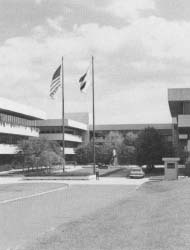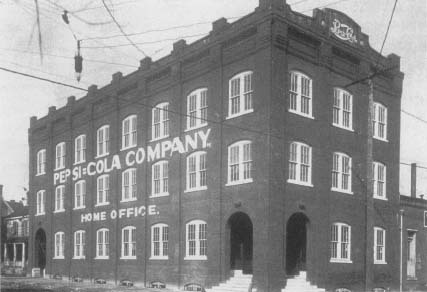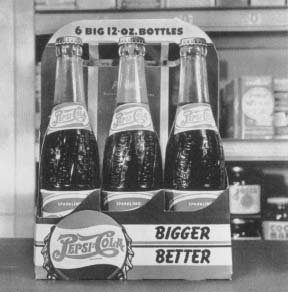PepsiCo, Inc.
700 Anderson Hill Road
Purchase, NY 10577-1444
(914) 253-2000
www.pepsico.com

With strong management and unique vision, PepsiCo, Inc., is not only a leader in the beverage and snack industry, it is one of the most successful companies in the world. Much of the company's success comes from the fact that it consistently stays in touch with changing trends and lifestyles, and gives consumers the tastes and conveniences they desire.
Over one hundred years after the first Pepsi was bottled, PepsiCo now offers thirty-two different kinds of carbonated and noncarbonated drinks with Pepsi-Cola beverages sold in 170 countries around the globe. It also produces thirty different kinds of snack foods and twenty-one cereals and other grain-related foods through its subsidiaries, Frito Lay and Quaker Oats. And, of course, the company continues its "cola war," battling rival Coca-Cola Company (see entry) to produce the beverage of choice.
Battle of Beverages
In 1893, Caleb "Doc" Bradham (1867-1934) opened a pharmacy in New Bern, North Carolina. Bradham was studying to be a doctor, but he was forced to leave medical school when his father lost his job. Many residents of the southern town frequented his drugstore, not only for the medicines Bradham provided but also to meet and talk with friends at the store's soda fountain. His customers especially enjoyed a beverage called "Brad's Drink," a combination of sugar, vanilla, oils, spices, the African kola nut, and carbonated water. Doc Bradham said the drink would help relieve the symptoms from dyspepsia, or an upset stomach, and ulcers.
It is not known if Doc Bradham had tasted a Coca-Cola in Atlanta, Georgia, where the drink, also sold as a medicinal beverage, had been invented several years earlier. Perhaps he heard about it in medical school. In any case, Bradham knew about "Coke" and succeeded in making a similar carbonated drink that brought customers to his store.
In 1898, Bradham changed the name of his popular drink to Pepsi-Cola and started his beverage business. At first, he mixed the syrup in his drugstore and shipped it in barrels to soda fountains where the carbonated water was added. He also bottled and sold Pepsi himself. After four successful years of distributing his new drink, Bradham patented the Pepsi-Cola trademark and closed his drugstore to devote all of his time to making, bottling, and selling Pepsi. By 1905, he had established his first two bottling franchises, or companies who purchased from him the right to bottle and sell Pepsi. In 1910, there were 250 Pepsi-Cola bottling franchises across the United States.
PepsiCo at a Glance
- Employees: 135,000
- CEO: Steven S. Reinemund
- Subsidiaries: Pepsi-Cola Company; Frito-Lay, Inc.; Pepsi Bottling Group, Inc.; Quaker Oats Company; South Beach Beverage Company; Tropicana Products, Inc.
- Major Competitors: Coca-Cola Company; Cadbury Schweppes; Kraft Foods
- Notable Products: Pepsi; Pepsi Twist; Pepsi One; Pepsi Blue; Diet Pepsi; Mountain Dew; Sierra Mist; Aquafina water; Lipton Brisk tea; FruitWorks fruit drinks; Doritos; Fritos; Ruffles potato chips; Tropicana orange juice; Quaker oatmeal; Life cereal; Aunt Jemima syrup; Gatorade
Pepsi-Cola's growth came to an abrupt end four years later when the price of sugar, one of Pepsi's key ingredients, skyrocketed because of rationing during World War I (1914-18). This means that sugar could be used only in small amounts. By 1922, the company had lost so much money that Bradham went bankrupt. In order to make enough money to pay off his debts, he had to sell the rights to the Pepsi-Cola formula. Bradham returned to his drugstore where he died twelve years later.
Timeline
- 1898:
- Caleb Bradham invents Pepsi-Cola.
- 1965:
- PepsiCo, Inc., is founded by Pepsi-Cola CEO Donald M. Kendall and Herman W. Lay, CEO of Frito-Lay.
- 1967:
- Pepsi Generation advertising campaign begins.
- 1976:
- The Pepsi Challenge becomes a national campaign after its introduction in Dallas, Texas, a year earlier.
- 1981:
- Frito-Lay begins nutritional labeling.
- 1984:
- Michael Jackson becomes the spokesman for "The Choice of a New Generation."
- 1988:
- Frito-Lay's Doritos becomes the world's largest selling snack chips.
- 1991:
- Commercials feature singer Ray Charles and the Uh-Huh Girls.
- 1993:
- Pepsi-Cola introduces freshness dating.
- 1996:
- Pepsico.com and Pepsi Stuff are unveiled.
- 2000:
- Pepsi Challenge is revived.
- 2002:
- PepsiCo introduces Gatorade ICE, Go Snacks, and Pepsi Blue.
Survive and Conquer
The ownership of Pepsi-Cola changed hands several times over the next ten years, barely surviving a second and third bankruptcy. It finally rested with Charles Guth, the owner of a New York-based candy and fountain store called Loft, Inc. Guth had been selling Coca-Cola, but became angry when Coke would not allow him to buy a large amount of syrup at a discounted price. He decided to switch to Pepsi although his customers were not sure they liked the new cola.

In 1934, sales of Pepsi increased mainly because of an important decision made by Guth. The United States was experiencing a devastating Depression, which lasted throughout the 1930s, and caused millions of people to be out of work. Guth decided to offer a twelve-ounce bottle of Pepsi for five cents—the same price as only six ounces of Coke. This was quite a bargain for people who were counting their pennies.
For the next two decades, the Pepsi-Cola Company, established in 1941, experienced steady growth due to continued good management and creative advertising. By 1954, the company was led by a former Coke employee, Alfred N. Steele (1901-1959), whose strength was in marketing. He also happened to be married to movie star Joan Crawford (1908-1977). The famous actress mentioned Pepsi during television interviews, and sometimes the product's vending machines and trucks were included in her movies. By 1960, Pepsi profits reached $14.2 million and the company was advertising their soft drink to "Those who think young."

Pepsi Generation
Pepsi-Cola enjoyed extraordinary success during the 1960s and 1970s mainly because of its new man in charge, Donald M. Kendall. Kendall was noted for leading his company in five major areas during this period: massive advertising; the introduction of new soft drink brands; creative packaging; overseas expansion; and product line expansion.
In 1963, Kendall and Pepsi made marketing history when the company changed the way it advertised its product. Instead of focusing on Pepsi the beverage, its television campaigns appealed directly to a specific group of people—baby boomers. Baby boomers were children born immediately after World War II (1939-45), between 1946 and 1964, and they numbered in the millions. Pepsi told them to "Come alive! You're in the Pepsi Generation." Advertising slogans that followed continued to target the energetic, youthful lifestyles of baby boomer teens. They also advised a generation of viewers who were experiencing significant social changes: "You've got a lot to live. Pepsi's got a lot to give" and "Join the Pepsi people, feelin' free."
As successful as Pepsi was during the 1960s, it was still trailing behind Coke. In response, Kendall thought it was important to expand the company' product line beyond soft drinks. At a grocer's convention in 1960, he met Herman W. Lay, the president and chief executive officer (CEO) of Frito-Lay, the nation's leading manufacturer of such snack foods as Lay's potato chips, Cheetos, Ruffles, and Rold Gold pretzels. The two decided to merge companies, and in 1965, PepsiCo, Inc. became the name of the new company. A year later they introduced Doritos, which eventually became the most popular snack chip in the United States.
Ups and Downs
By the 1980s, PepsiCo had become a major competitor in the fast food, snack food, and beverage market. They had acquired three restaurant chains, Pizza Hut, Taco Bell, and Kentucky Fried Chicken, which they later sold in 1997; introduced several new soft drinks, including Diet Pepsi, Pepsi Free, and Slice; and signed one of the world's most exciting and talented superstars, Michael Jackson (1958-). This alliance began a long line of pop stars who used their talents to promote PepsiCo products.
Along with its successes, the company went through a period of uncertainty and scandal in the 1980s. In the Philippines and Mexico, PepsiCo employees had been caught using false documents to make it look like the company was making more money than it really was. The publicized scandal caused PepsiCo's 1982 profits to plunge by 25 percent. Profits continued to decrease in 1983 when the value of the peso, Mexico's currency, dropped dramatically. At that time, Mexico provided PepsiCo with the largest sales of soft drinks and snacks in the international market.
In 1940, Pepsi introduced the world's first radio jingle. Called "Nickel, Nickel," the catchy tune explained that: "Pepsi-Cola hits the spot/Twelve full ounces that's a lot/Twice as much for a nickel, too/Pepsi-Cola is the drink for you."
But help was soon on the way for PepsiCo. In the summer of 1985, Coca-Cola decided to change the recipe of their century-old syrup. They introduced a new and improved taste called New Coke, saying it had a milder taste than the original version. According to PepsiCo, the rival company was trying to make Coke taste more like Pepsi. PepsiCo anticipated that the new formula would entice consumers to finally switch brands, so they released full-page Pepsi advertisements on the day it was announced that New Coke would replace the old. What happened surprised everyone. Instead of die-hard fans switching colas, they demanded their old Coke be returned. After only ninety days on the market, New Coke was canned, and Coca-Cola introduced the restored formula in Coca-Cola Classic. During this brief period, while tasters were trying to make up their minds, Pepsi enjoyed a brief lead in the cola wars.
Beverages and Beyond
For the next decade and through the turn of the century, PepsiCo expanded to include products that would keep it competitive in a continually growing and changing market. As consumers became more and more conscious of their health and eating habits, PepsiCo answered their needs. In the late 1990s, they introduced Aquafina bottled water, acquired Tropicana fruit juices, bought the South Beach Beverage Company, which manufactures SoBe juice blends, and acquired the company whose name is synonymous with healthy eating, Quaker Oats. Healthy food was not the only benefit in this merger. It just so happened that Quaker owned the sports drink, Gatorade.
In 1976, PepsiCo launched a head-to-head combat with Coke by offering drinkers a blind taste test to see whether they could tell the difference between the two colas. The marketing campaign, known as the Pepsi Challenge, was so successful, the company decided to revive it in 2000.
PepsiCo also answered the needs of the growing ethnic population of the United States. According to Tom Pirko, president of beverage consultant Bevmark, in a 2001 Advertising Age article, "More than one third of America's youth are Hispanic or black. Soft drinks are more popular among minorities than Caucasians and among youth than their parents." In response, PepsiCo launched three new drinks to meet these demands: Sierra Mist (a lemon-lime soda), Mountain Dew Code Red, and Pepsi Blue (a cola and berry beverage). According to a 2002 New York Times article, "Both Code Red and Pepsi Blue have sixteen-year-old males as their target consumer."
Promoting Pepsi
Many consumers enjoy PepsiCo's products because of the company's entertaining and memorable commercials. Some of the most well-known include "Apartment 10G" starring Michael j. Fox (1961-); "You Got the Right One Baby, Uh-Huh!" sung by Ray Charles (1930-) and the Uh-Huh Girls; "Joy of Cola" featuring a little girl named Hallie Eisenberg; "Joy of Pepsi" with Britney Spears (1981—); and "A Twist on a Great Thing," which paired Mike Meyers (1964-) as Austin Powers with pop sensation Spears.
The launch of a new Pepsi commercial eventually became a much anticipated event that millions tuned in to watch. Savvy Pepsi marketers usually guaranteed an already big audience by debuting their ads during top-rated television programs. For example, Pepsi spent $6 million to advertise during the Super Bowl in 1992. In 2002, PepsiCo reportedly paid $200 million for a five-year deal to advertise during NFL events such as the Super Bowl and Pro Bowl.
Pepsi's advertising is not limited to television. In 2000, PepsiCo teamed with one of the Internet's largest navigation companies, Yahoo, to promote its products. A year later on PepsiStuff.com , consumers could redeem points from Pepsi packages to get "more than a half a million cool prizes."
As Pepsi introduced new products to keep up with the times, it also continued to be neck and neck in the cola race. According to the 2002 Soft Drink Report published in Beverage Industry, Pepsi-Cola had 34.5 percent of the United States market for carbonated beverages while Coca-Cola had 36.2 percent. The fight goes on, but the gap draws ever closer. As former PepsiCo CEO Roger Enrico said in his book The Other Guy Blinked: How Pepsi Won the Cola Wars, "At Pepsi, we like the Cola Wars.… Without Coke, Pepsi would have a tough time being an original and lively competitor. The more successful they are, the sharper we have to be."
Comment about this article, ask questions, or add new information about this topic: